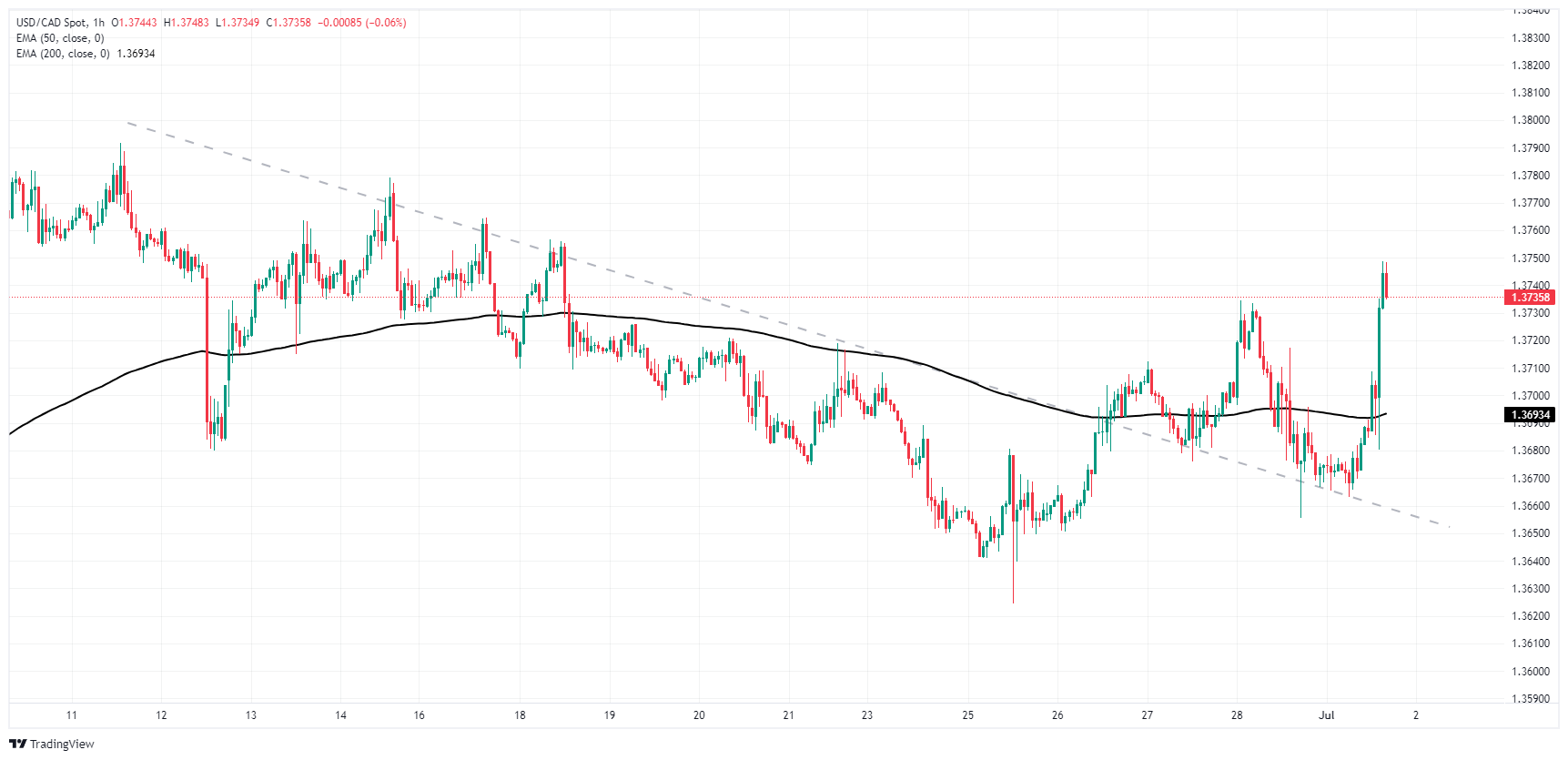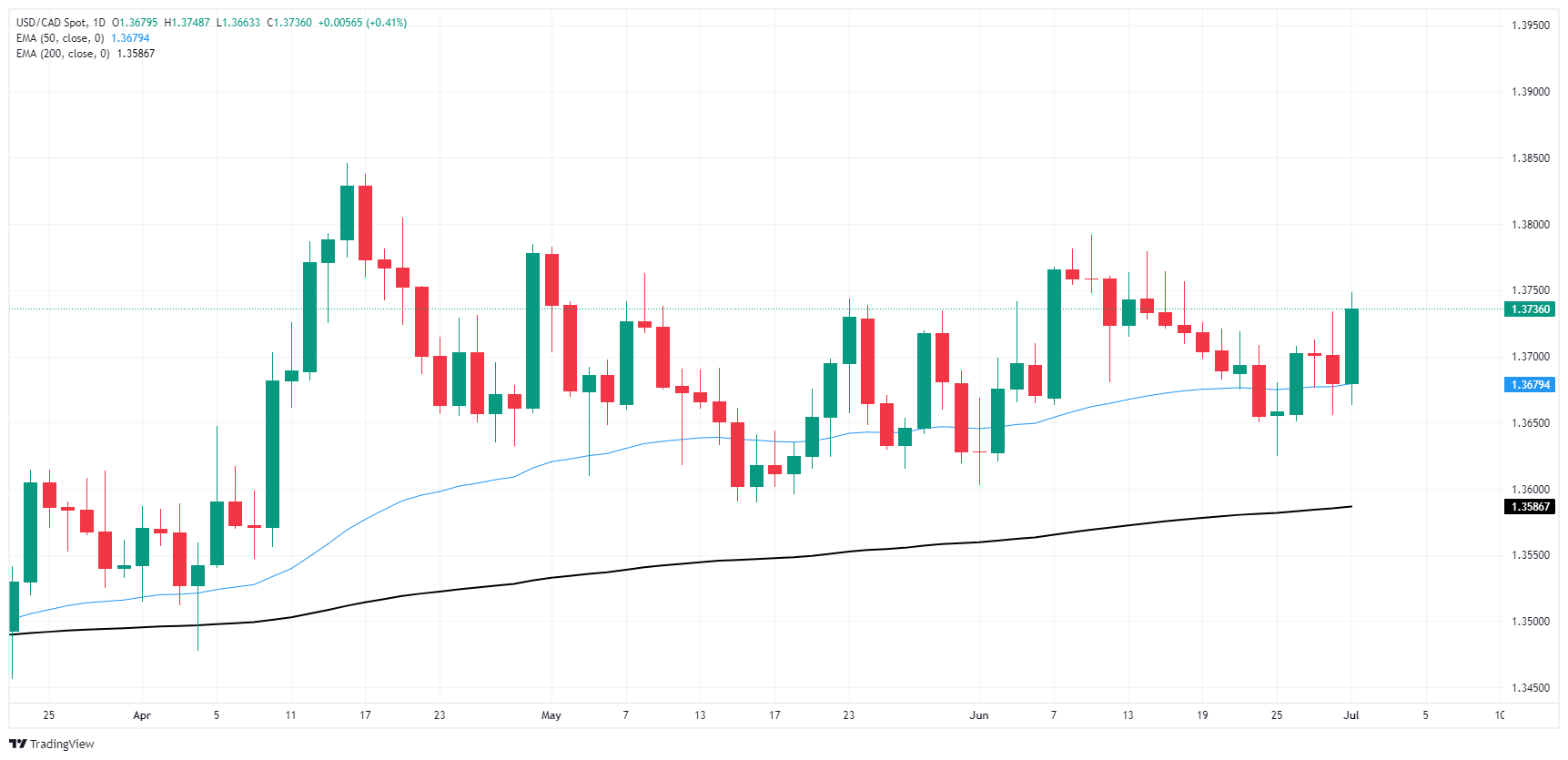- Analytics
- News and Tools
- Market News
- Canadian Dollar plummets on Monday holiday markets
Canadian Dollar plummets on Monday holiday markets
- Canadian Dollar sheds half of a percent against the Greenback.
- Canada Day holiday leaves CAD markets in the dark for Monday.
- Canadian data remains limited this week until NFP Friday.
The Canadian Dollar (CAD) broadly retreated on Monday, as Canadian markets were dark for the Canada Day long weekend. CAD traders will be returning to the fold on Tuesday just in time for a fresh print of Canadian S&P Global Manufacturing Purchasing Managers Index (PMI) figures.
Canada has a largely empty dance card on this week’s economic calendar. Outside of Tuesday’s upcoming PMI print, little of note comes from the Canadian side until Friday’s labor figures, which will largely get drowned out by another round of US Nonfarm Payrolls (NFP).
Daily digest market movers: Canadian holiday leaves the CAD adrift
- Safe haven bids have broadly bolstered the US Dollar on Monday.
- Canadian Dollar takes pride of place as the single worst-performing major currency to kick off the new trading week.
- US ISM Manufacturing PMI figures for June printed worse than expected, backsliding to 48.5 from 48.7, missing the forecast uptick to 49.1.
- US ISM Manufacturing Price Paid, a measure of industry-level inflation expectations, retreated sharply in June, falling to 52.1 from 57.0, a far steeper drop than the forecast 55.9.
- Recession jitters are crimping risk appetite on Monday as wobbly US data prints tilt further into slowdown territory.
Canadian Dollar PRICE Today
The table below shows the percentage change of Canadian Dollar (CAD) against listed major currencies today. Canadian Dollar was the strongest against the Swiss Franc.
| USD | EUR | GBP | JPY | CAD | AUD | NZD | CHF | |
|---|---|---|---|---|---|---|---|---|
| USD | -0.15% | -0.08% | 0.45% | 0.46% | 0.20% | 0.37% | 0.60% | |
| EUR | 0.15% | -0.14% | 0.31% | 0.31% | 0.24% | 0.21% | 0.45% | |
| GBP | 0.08% | 0.14% | 0.43% | 0.47% | 0.39% | 0.36% | 0.61% | |
| JPY | -0.45% | -0.31% | -0.43% | 0.00% | -0.19% | -0.09% | 0.18% | |
| CAD | -0.46% | -0.31% | -0.47% | -0.01% | -0.22% | -0.10% | 0.14% | |
| AUD | -0.20% | -0.24% | -0.39% | 0.19% | 0.22% | -0.03% | 0.29% | |
| NZD | -0.37% | -0.21% | -0.36% | 0.09% | 0.10% | 0.03% | 0.27% | |
| CHF | -0.60% | -0.45% | -0.61% | -0.18% | -0.14% | -0.29% | -0.27% |
The heat map shows percentage changes of major currencies against each other. The base currency is picked from the left column, while the quote currency is picked from the top row. For example, if you pick the Canadian Dollar from the left column and move along the horizontal line to the US Dollar, the percentage change displayed in the box will represent CAD (base)/USD (quote).
Technical analysis: Canadian Dollar falls across the board, USD/CAD finds fresh highs
The Canadian Dollar (CAD) tumbled across the board on Monday, shedding around one-half of one percent against the US Dollar, Australian Dollar, and Pound Sterling. The CAD also shed a fifth of a percent against the Australian Dollar and around one-tenth of one percent against the Japanese Yen.
USD/CAD found a fresh multi-week high after testing into 1.3750 on Monday. The pair has recovered ground after bouncing from last week’s plunge below 1.3630. Still, intraday price action continues to trade on the rough side as the pair cycles the 200-hour Exponential Moving Average (EMA).
Daily candlesticks continue to find a foothold above the 50-day EMA at 1.3679, but bidding pressure will still need to gather enough steam to break north of June’s peak bids just shy of the 1.3800 handle.
USD/CAD hourly chart
USD/CAD daily chart
Canadian Dollar FAQs
The key factors driving the Canadian Dollar (CAD) are the level of interest rates set by the Bank of Canada (BoC), the price of Oil, Canada’s largest export, the health of its economy, inflation and the Trade Balance, which is the difference between the value of Canada’s exports versus its imports. Other factors include market sentiment – whether investors are taking on more risky assets (risk-on) or seeking safe-havens (risk-off) – with risk-on being CAD-positive. As its largest trading partner, the health of the US economy is also a key factor influencing the Canadian Dollar.
The Bank of Canada (BoC) has a significant influence on the Canadian Dollar by setting the level of interest rates that banks can lend to one another. This influences the level of interest rates for everyone. The main goal of the BoC is to maintain inflation at 1-3% by adjusting interest rates up or down. Relatively higher interest rates tend to be positive for the CAD. The Bank of Canada can also use quantitative easing and tightening to influence credit conditions, with the former CAD-negative and the latter CAD-positive.
The price of Oil is a key factor impacting the value of the Canadian Dollar. Petroleum is Canada’s biggest export, so Oil price tends to have an immediate impact on the CAD value. Generally, if Oil price rises CAD also goes up, as aggregate demand for the currency increases. The opposite is the case if the price of Oil falls. Higher Oil prices also tend to result in a greater likelihood of a positive Trade Balance, which is also supportive of the CAD.
While inflation had always traditionally been thought of as a negative factor for a currency since it lowers the value of money, the opposite has actually been the case in modern times with the relaxation of cross-border capital controls. Higher inflation tends to lead central banks to put up interest rates which attracts more capital inflows from global investors seeking a lucrative place to keep their money. This increases demand for the local currency, which in Canada’s case is the Canadian Dollar.
Macroeconomic data releases gauge the health of the economy and can have an impact on the Canadian Dollar. Indicators such as GDP, Manufacturing and Services PMIs, employment, and consumer sentiment surveys can all influence the direction of the CAD. A strong economy is good for the Canadian Dollar. Not only does it attract more foreign investment but it may encourage the Bank of Canada to put up interest rates, leading to a stronger currency. If economic data is weak, however, the CAD is likely to fall.
© 2000-2024. All rights reserved.
This site is managed by Teletrade D.J. LLC 2351 LLC 2022 (Euro House, Richmond Hill Road, Kingstown, VC0100, St. Vincent and the Grenadines).
The information on this website is for informational purposes only and does not constitute any investment advice.
The company does not serve or provide services to customers who are residents of the US, Canada, Iran, The Democratic People's Republic of Korea, Yemen and FATF blacklisted countries.
Making transactions on financial markets with marginal financial instruments opens up wide possibilities and allows investors who are willing to take risks to earn high profits, carrying a potentially high risk of losses at the same time. Therefore you should responsibly approach the issue of choosing the appropriate investment strategy, taking the available resources into account, before starting trading.
Use of the information: full or partial use of materials from this website must always be referenced to TeleTrade as the source of information. Use of the materials on the Internet must be accompanied by a hyperlink to teletrade.org. Automatic import of materials and information from this website is prohibited.
Please contact our PR department if you have any questions or need assistance at pr@teletrade.global.















